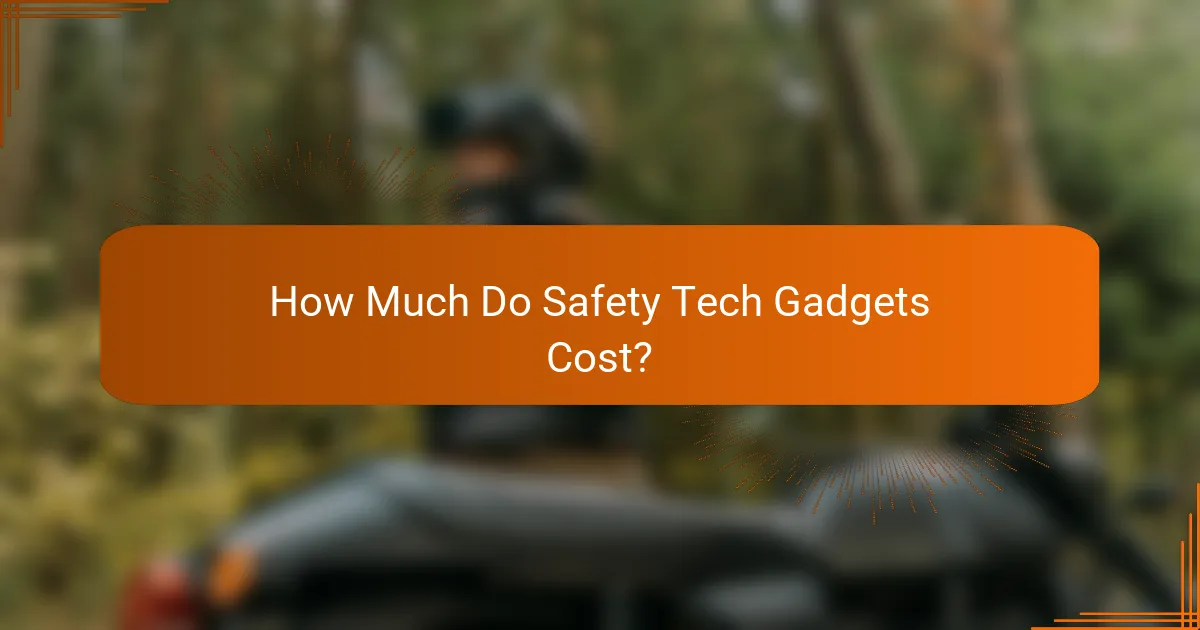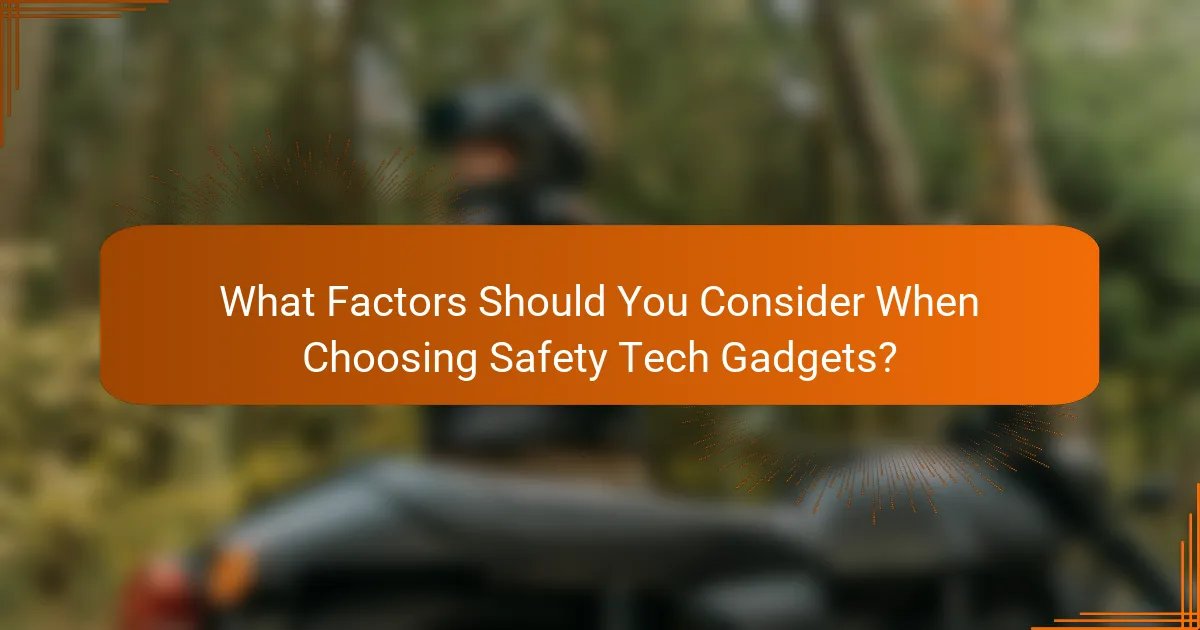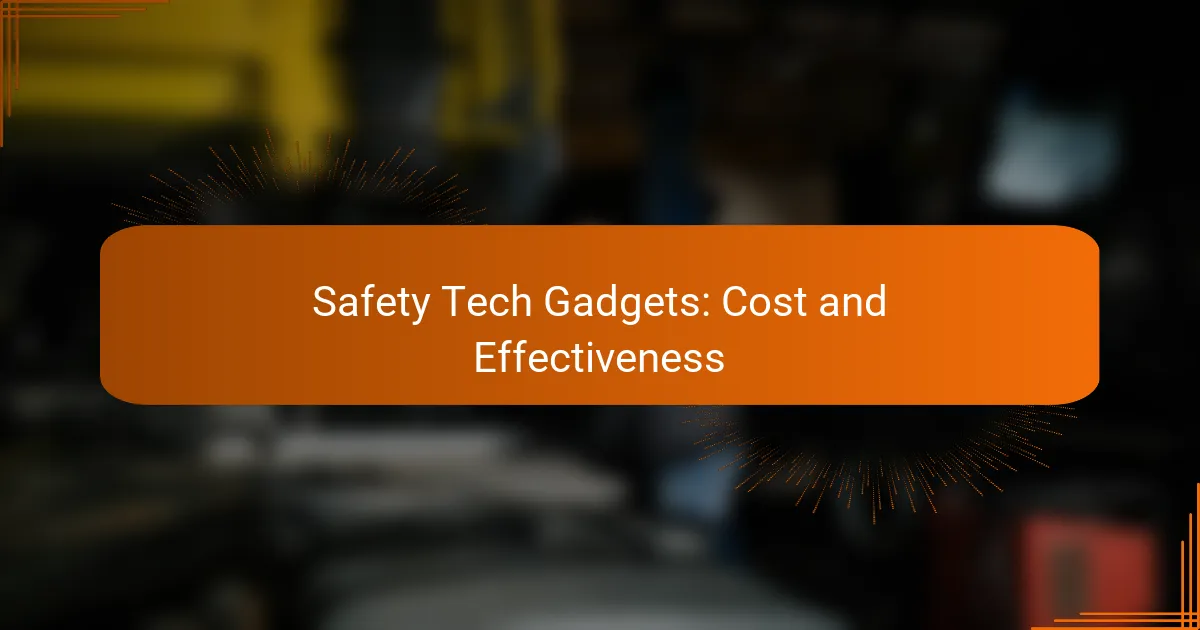Safety tech gadgets play a crucial role in enhancing security and providing peace of mind through innovative technology. With a wide range of devices available, from smoke detectors to smart cameras, understanding their costs and effectiveness can help consumers make informed choices to protect their homes and personal safety.

What Are the Most Effective Safety Tech Gadgets?
The most effective safety tech gadgets enhance security and provide peace of mind through advanced technology. These devices range from smoke detectors to wearable safety tools, each designed to address specific safety concerns in homes and personal environments.
Smart Smoke Detectors
Smart smoke detectors are advanced devices that not only detect smoke but also send alerts to your smartphone. They often include features like carbon monoxide detection and self-testing capabilities, ensuring they are always functional.
When choosing a smart smoke detector, consider models that integrate with your home automation system. Look for options that provide real-time alerts and have a long battery life, ideally lasting several years.
Home Security Cameras
Home security cameras allow you to monitor your property remotely, providing a visual deterrent against intruders. Many models offer features like night vision, motion detection, and cloud storage for recorded footage.
For effective home surveillance, select cameras with high resolution and wide-angle lenses. Ensure they are weather-resistant if placed outdoors, and consider systems that allow for easy integration with your smartphone for instant notifications.
Personal Safety Alarms
Personal safety alarms are compact devices that emit a loud sound when activated, drawing attention in emergencies. They are easy to carry and can be attached to keychains or bags for quick access.
When selecting a personal safety alarm, look for models with a sound level of at least 120 decibels. Consider features like LED lights or built-in whistles for added functionality in various situations.
Smart Locks
Smart locks provide keyless entry to your home, allowing you to control access through your smartphone or a keypad. They often include features such as remote locking and unlocking, as well as temporary access codes for guests.
Choose smart locks that are compatible with your existing door hardware and offer robust security features like encryption. Look for models that can withstand extreme weather conditions and have a backup key option in case of battery failure.
Wearable Safety Devices
Wearable safety devices, such as smartwatches or fitness trackers with emergency features, can alert authorities in case of distress. Many models include fall detection and SOS buttons that send your location to emergency contacts.
When considering a wearable safety device, prioritize battery life and comfort for daily wear. Ensure the device has reliable connectivity options, such as cellular or Wi-Fi, to maintain communication in emergencies.

How Much Do Safety Tech Gadgets Cost?
The cost of safety tech gadgets varies widely based on features and brand, typically ranging from low tens to several hundred dollars. Understanding the price ranges for specific categories can help you make informed purchasing decisions.
Average Prices for Smart Smoke Detectors
Smart smoke detectors generally cost between $50 and $150. These devices often include features like smartphone alerts and integration with home automation systems. Investing in a quality model can enhance your home safety by providing real-time notifications.
Cost Range for Home Security Cameras
Home security cameras can range from about $30 for basic models to over $300 for high-end options with advanced features. Factors influencing the price include video resolution, storage options, and whether the camera is wired or wireless. Consider your specific security needs when selecting a model.
Pricing for Personal Safety Alarms
Personal safety alarms are typically priced between $10 and $50. These compact devices emit loud sounds to deter attackers and alert others nearby. When choosing a personal safety alarm, look for features like portability and ease of use.
Smart Lock Price Comparison
Smart locks usually cost between $100 and $300, depending on the technology and features. Options include keyless entry, remote access, and integration with smart home systems. Evaluate the security level and convenience features to find the right lock for your needs.
Wearable Device Costs
Wearable safety devices, such as smartwatches with emergency features, can range from $50 to over $500. Prices vary based on functionality, brand, and additional health monitoring capabilities. When selecting a wearable, consider both safety features and overall usability for daily wear.

What Are the Benefits of Using Safety Tech Gadgets?
Safety tech gadgets provide enhanced protection, convenience, and peace of mind for users. These devices, ranging from smart cameras to alarm systems, are designed to improve security and facilitate quick responses in emergencies.
Enhanced Home Security
Safety tech gadgets significantly bolster home security by deterring intruders and monitoring activities. Devices such as smart locks, security cameras, and motion detectors can be easily integrated into a home’s existing infrastructure.
For effective home security, consider a combination of indoor and outdoor cameras, as well as smart lighting systems that can simulate occupancy. The investment can range from a few hundred to several thousand dollars, depending on the complexity and features of the system.
Peace of Mind for Users
Using safety tech gadgets offers users peace of mind, knowing they are protected against potential threats. Many devices provide remote access, allowing homeowners to monitor their property from anywhere via smartphone apps.
This reassurance can be particularly valuable for families with children or elderly members, as they can receive alerts and check on their loved ones easily. Regular updates and maintenance of these gadgets are essential to ensure they function optimally.
Real-Time Alerts and Monitoring
Real-time alerts and monitoring are crucial features of safety tech gadgets. Many systems send immediate notifications to users’ smartphones in case of unusual activities, such as unauthorized entry or smoke detection.
These alerts enable users to respond quickly, potentially preventing damage or injury. When choosing a system, look for one that offers customizable alert settings and reliable connectivity to ensure timely notifications.
Integration with Smart Home Systems
Safety tech gadgets can seamlessly integrate with existing smart home systems, enhancing overall functionality. This integration allows users to control multiple devices through a single interface, simplifying management and improving efficiency.
For instance, a smart security system can work in tandem with smart lights and thermostats, creating a cohesive environment that responds to user preferences. Ensure compatibility with your current smart home ecosystem when selecting new devices.
Improved Emergency Response
Safety tech gadgets can significantly improve emergency response times. Many systems are designed to automatically contact emergency services when a threat is detected, such as a break-in or fire.
Additionally, some devices can provide real-time location data to first responders, allowing for quicker assistance. When investing in safety gadgets, consider those that offer direct emergency contact features and are compliant with local regulations for maximum effectiveness.

What Factors Should You Consider When Choosing Safety Tech Gadgets?
When selecting safety tech gadgets, consider compatibility, ease of use, effectiveness, and cost. These factors will help ensure that the devices you choose enhance your safety without adding unnecessary complexity or expense.
Compatibility with Existing Systems
Compatibility is crucial when choosing safety tech gadgets, as they need to integrate seamlessly with your current systems. Check if the new devices can connect with existing security cameras, alarms, or smart home systems to avoid functionality issues.
For example, if you have a smart home hub, ensure that the safety gadgets you consider are compatible with it. Look for devices that support common protocols like Z-Wave or Zigbee, which can enhance interoperability.
Before purchasing, review user manuals or product specifications to confirm compatibility. This can save you from potential frustration and additional costs associated with replacing incompatible devices.
